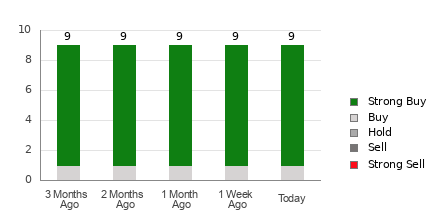When pondering whether to invest in a stock, individuals often turn to the guidance provided by analyst recommendations. The opinions of these financial experts can significantly influence market activity, but can they truly be relied upon?
Before we delve into the trustworthiness of brokerage recommendations and how investors can leverage them to their advantage, let’s examine the sentiments expressed by prominent Wall Street analysts about Vistra Corp. (VST).
Vistra currently boasts an average brokerage recommendation (ABR) of 1.11 on a scale ranging from 1 to 5 (Strong Buy to Strong Sell), derived from assessments by nine brokerage firms. An ABR of 1.11 typically falls between a Strong Buy and Buy rating.
Out of the nine recommendations contributing to the ABR, an overwhelming eight are labeled as Strong Buy, with just one receiving a Buy rating. Notably, Strong Buy and Buy constitute 88.9% and 11.1% of the total recommendations, respectively.
Examination of Vistra’s Brokerage Recommendation Trends

While the ABR advocates for investing in Vistra, it may be imprudent to base investment decisions solely on this metric. Studies have revealed the limited effectiveness of brokerage recommendations in identifying stocks with the most potential for price appreciation.
But why is this the case? Analysts at brokerage firms often exhibit a notable bias towards stocks they cover, creating a pronounced positive slant in their ratings. Research indicates that for every “Strong Sell” recommendation issued, analysts assign five “Strong Buy” recommendations.
Fundamentally, the interests of brokerage analysts may not invariably align with those of retail investors, offering limited insight into a stock’s future price trajectory. Therefore, it is recommended to use this information for corroborating your own research or as an additional indicator to enhance the accuracy of predicting stock price movements.
The Distinction Between ABR and Zacks Rank
It should be noted that although both the ABR and Zacks Rank use a 1-5 ranking system, they serve different purposes altogether.
While the ABR is solely derived from brokerage recommendations and typically includes decimals (e.g., 1.28), the Zacks Rank operates as a quantitative model that leverages earnings estimate revisions, presented as whole numbers ranging from 1 to 5.
In stark contrast to brokerage-recommended ratings, the Zacks Rank is predicated on earnings estimate revisions, with empirical evidence showcasing a strong correlation between short-term stock price movements and trends in earnings estimate revisions.
Moreover, the Zacks Rank’s various grades are equitably distributed across all stocks for which brokerage analysts furnish earnings estimates for the current fiscal year. This equitable allocation ensures a balanced representation among the five ranks assigned by the tool.
One pivotal discrepancy between the ABR and Zacks Rank pertains to timeliness. While the ABR may lack real-time updates, the Zacks Rank swiftly incorporates changes in earnings estimates by brokerage analysts, rendering it consistently reliable for anticipating future stock prices.
Assessing the Viability of Investing in VST
Regarding earnings estimate revisions for Vistra, the Zacks Consensus Estimate for the ongoing year has held steady at $4.86 over the past month.
The stable consensus estimate, reflective of analysts’ unwavering stance on the company’s earnings outlook, suggests that Vistra’s stock performance may align with broader market trends in the near future.
Based on the magnitude of the recent consensus estimate adjustment alongside other pertinent factors related to earnings estimates, Vistra currently holds a Zacks Rank #3 (Hold). For a detailed list of Zacks Rank #1 (Strong Buy) stocks, visit here.





